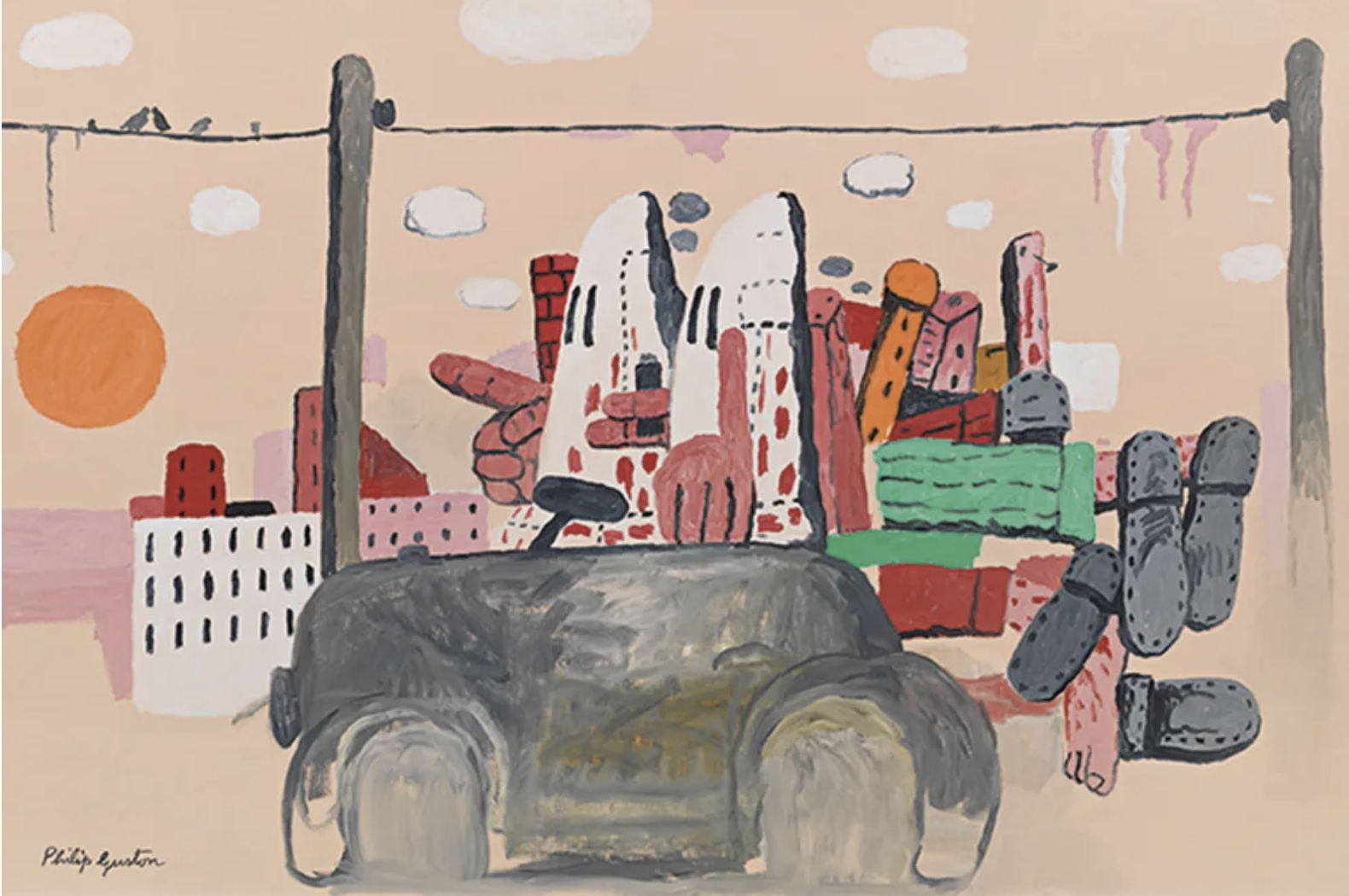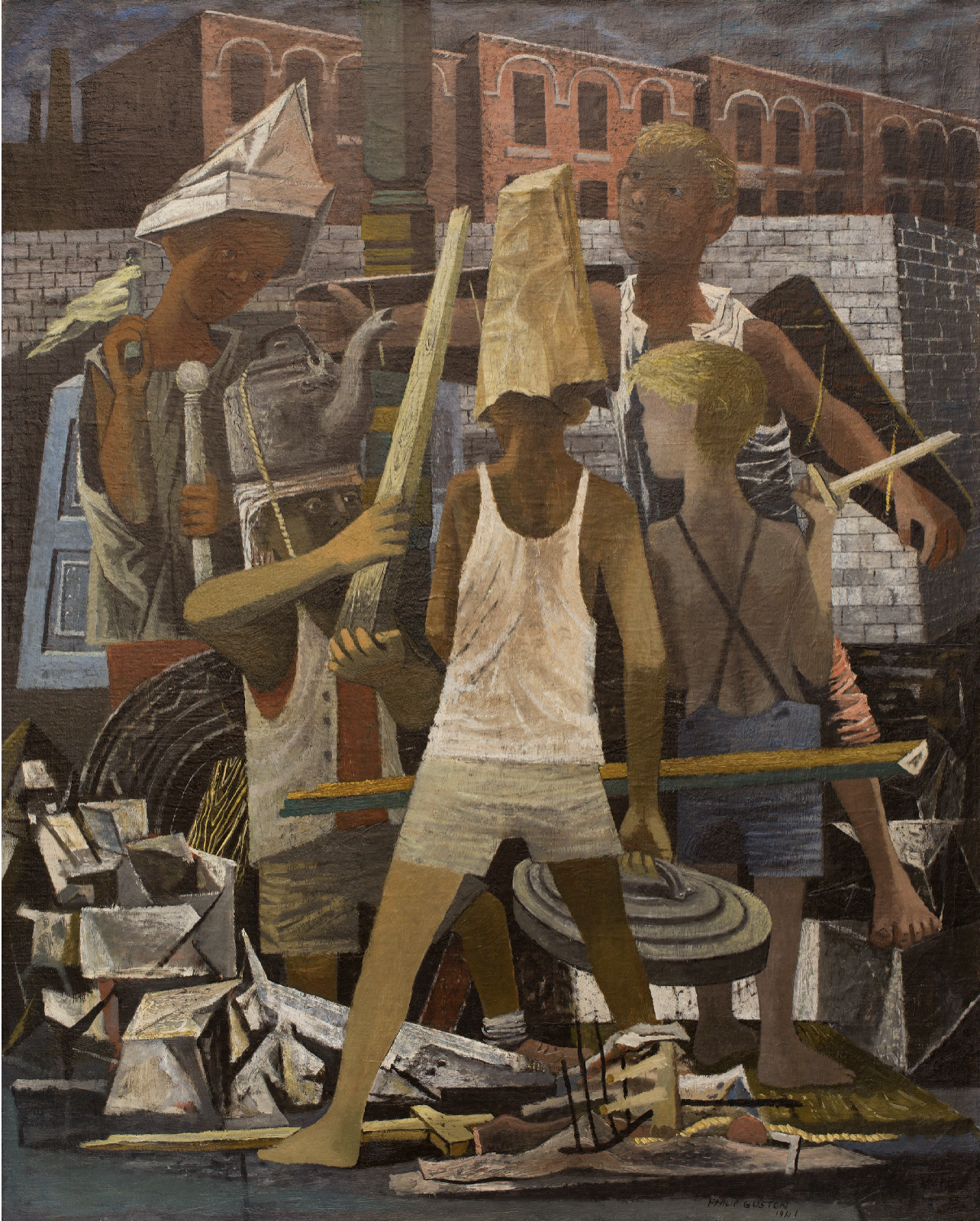Philip Guston’s Art of Anxiety: Not Inventing, But Revealing
Dawn (1970), Philip Guston, oil on canvas. Glenstone Museum, Maryland
‘Well, it could be all of us. We’re all hoods.’
Philip Guston
I recently visited a fine exhibition of the work of Philip Guston. (Tate Modern, London, until 25 February)
Guston was a fiercely political artist, raging at injustices he saw all around him. He articulated his anger and anxiety through narrative murals and allegorical paintings, through abstract works and depictions of dark cartoonish nightmares. He was a restless soul who believed the role of the artist was not to invent fictions, but to reveal truths. He pleads with us to care, and prompts us to reflect on the enemy within – within our society and within ourselves.
‘I feel that I have not invented so much as revealed in a coded way, something that already existed.’
He was born Phillip Goldstein in Montreal in 1913, the youngest of seven children. His Jewish parents had fled persecution in present-day Ukraine. In 1922 the family moved to Los Angeles, where, struggling to make ends meet, his father, a scrap collector, hanged himself in the shed - and 10 year old Phillip found the body.
Philip Guston in New York, in 1952 Martha Holmes/The LIFE Images Collection, via Getty Images
As a child Goldstein was interested in cartoons and Renaissance art. At 14 he began painting, and enrolled in the Los Angeles Manual Arts High School where he met Jackson Pollock, who became a life-long friend.
‘I grew up politically in the thirties and I was actively involved in militant movements and so on, as a lot of artists were… I think there was a sense of being part of a change, or possible change.’
Goldstein became politically active as the United States saw the rise of racism and antisemitism; and the resurgence of the Ku Klux Klan. He joined a group of artists creating large-scale narrative murals supporting workers’ rights and resistance to fascism and oppression.
'Frustration is one of the great things in art. Satisfaction is nothing.’
In 1935, at 22, Goldstein moved to New York where, concerned about the climate of antisemitism, he changed his name to Philip Guston. He was deeply affected by the war in Europe and the Holocaust. And so he turned to his easel and painted the bombing of Guernica; children playing and fighting in ruined townscapes; haunted camp inmates.
‘That’s the only reason to be an artist… to bear witness.’
Martial Memory Philip Guston, 1941, Oil on Canvas
In the late 1940s, suffering a crisis of confidence, Guston destroyed everything he’d been working on. Perhaps he felt figurative painting could not do justice to the horrors that had so recently taken place.
‘I began to feel that I could really learn, investigate, by losing a lot of what I knew.’
He decided to change course, and immersed himself in New York’s emerging Abstract Expressionist scene, hanging out with Rothko, de Kooning and Kline.
‘The trouble with recognisable art is that it excludes too much. I want my work to include more. And ‘more’ also comprises one’s doubts about the object, plus the problem, the dilemma, of recognising it.’
Standing close to the canvas, Guston painted forms coming into existence – perhaps you can detect a body or a head - using gentle, complementary colours. Critics dubbed him an ‘abstract impressionist.’ His favourite shade was cadmium red, and it would continue to feature strongly in his work for the rest of his career.
‘I like pastrami. I just like it. I couldn’t tell you why.’
Beggar's joys, Philip Guston, 1954–1955 oil on canvas
In the late ‘60s Guston was deeply moved by the Vietnam War and the political upheaval in the United States.
‘The war, what was happening to America, the brutality of the world. What kind of man am I, sitting at home reading magazines, going into a frustrated fury about everything – and then going into my studio to adjust a red to a blue?’
Feeling that his art had to make more overt political statements, Guston made a dramatic return to figurative work.
‘The hell with it. I just wanted to draw solid stuff.’
He had always liked comics, and his new images drew on George Herriman’s Krazy Kat. He painted cartoonish, blood-spattered Klan figures driving around town in a childish car, pointing at the sights, the legs of a man projecting from the boot. He depicted similar hoods relaxing at home with a cigarette by the window; in the courtroom, at the office and drawn on blackboards - suggesting they were part of the curriculum.
'Look at any inspired painting. It's like a gong sounding; it puts you in a state of reverberation.’
Where previously Guston had shown Klansmen conspiring, in the act of racial assault, here they were engaged in the mundane activities of everyday life. It was as if he was saying: evil is all around us; it is institutional, systemic - in our courts and schools and on our streets; it is hiding in plain sight.
‘My attempt was really not… to do pictures of the KKK, as I had done earlier. The idea of evil fascinated me… I almost tried to imagine that I was living with the Klan. What would it be like to be evil? To plan and plot?’
Most striking among these works was a picture of a hooded artist at work in the studio, painting himself.
‘I perceive myself behind the hood.’
The Studio, Philip Guston, 1969 Oil on canvas
Guston implies that we are all complicit in the injustices we see around us. We carry with us our own prejudices and partialities; our unconscious biases; our inertia and failure to act. We should turn our critical faculties on ourselves.
'There is another man within me that’s angry with me.’
Thomas Browne
Guston presented his startling new work at the Marlborough Gallery in New York in 1970. But the show was not a success and he only sold one painting. Critics were hugely disappointed that he had deserted the abstract cause, and he lost friends as a result.
‘There is nothing to do now, but paint my life; my dreams, surroundings, predicament, desperation, [my wife] Musa – love, need.’
Depressed at the response, Guston turned to painting strange dreamscapes populated by objects that meant something to him – mental junk that he called ‘crapola.’ Repeatedly he depicted cigarettes, irons, clocks and steaming kettles; clocks, blinds and bare bulbs; sinister dangling light-pulls. And everywhere there were old shoes and severed legs - echoes of the Holocaust.
'The canvas is a court where the artist is prosecutor, defendant, jury and judge. Art without a trial disappears at a glance.’
In 1973 Guston painted himself: pastrami-pink, indolent, smoking in bed with a plate of ketchupped chips on his chest and a stack of shoes at his side. There’s a bare light bulb and a light-pull. His paintbrushes sit unused. It’s a desolate image.
Interviewer: Do you think of yourself as kind of pessimistic?
Guston: I don’t think it’s pessimistic. I think it’s doomed.
In 1980 Guston died of a heart attack, in Woodstock, New York. He was 66.
Smoking, Eating . Philip Guston (1973). Stedelijk Museum Amsterdam/The Estate of Philip Guston
Guston was clearly a melancholy figure. But he demonstrated that, even at our lowest ebb, we can find some solace in art. He teaches us to be restless; to embrace radical change when we’re running out of steam; to see the enemy within; and to turn our critical judgement on ourselves.
‘Probably the only thing one can really learn, the only technique to learn, is the capacity to be able to change.’
'People just ain't no good,
I think that's well understood.
You can see it everywhere you look,
People just ain't no good.
It ain't that in their hearts they're bad.
They can comfort you, some even try.
They nurse you when you're ill of health,
They bury you when you go and die.
It ain't that in their hearts they're bad.
They'll stick by you if they could.
Ah, but that's just bullshit, baby.
People just ain't no good.
People they ain't no good.
People they ain't no good.
People they ain't no good at all.’
Nick Cave and the Bad Seeds,'People Ain't No Good’ (N Cave)
No. 445





